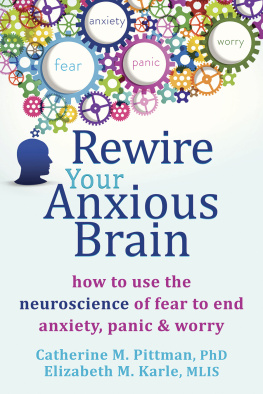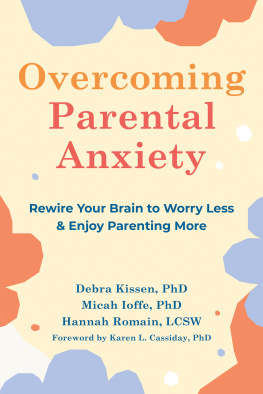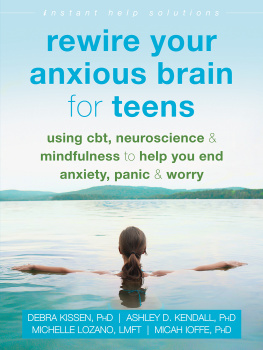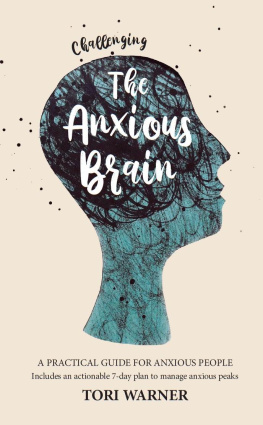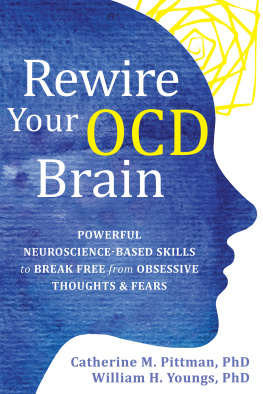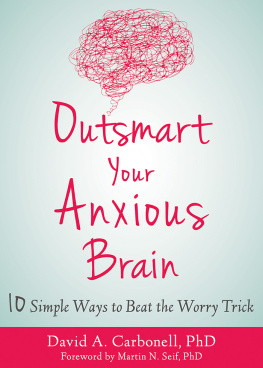Catherine M. Pittman, PhD, is associate professor at Saint Marys College in Notre Dame, IN. As a licensed clinical psychologist in private practice in South Bend, IN, she specializes in the treatment of brain injuries and anxiety disorders. She is a member of the Anxiety and Depression Association of America (ADAA), and provides workshops and seminars on the topics of anxiety and stress.
Elizabeth M. Karle, MLIS, is collection management supervisor at the Cushwa-Leighton Library at Saint Marys College in Notre Dame, IN. In addition to supplying research for this book, she has personal experience with anxiety disordersproviding a first-hand perspective that focuses the book on what is most useful for the anxiety sufferer. Originally from Illinois, she currently resides in South Bend, IN, and holds degrees or certificates from the University of Notre Dame, Roosevelt University, and Dominican University. She is author of Hosting a Library Mystery.

From fears to phobias and panic, this how-to guide unravels the mysteries of worry, then delivers strategies that will lead you to a resilient life.
Reid Wilson, PhD, author of Dont Panic
Fear, worry, anxiety, panic, and depression block individuals from living fully. This book does an excellent job of unraveling the mysteries of the brain and how it causes anxiety, thus allowing individuals to take control of their symptoms and manage their lives more effectively. I have used the concepts in this book in treating veterans with PTSD and have seen people become much more functional. Highly-recommended reading.
Susan Myers, RN, LCSW, BCD, holistic nurse and board certified diplomate in clinical social work
This is a unique contribution to a wide array of self-help books for those who suffer with anxiety. The authors explain what we know about the workings of the brain in a fluid style that neither talks down to nor overwhelms the reader. This science becomes the foundation for decreasing bewilderment, fear, and shame. There are straightforward and logical recommendations for modifying patterns of anxiety that originate from, and are maintained by, differing brain circuitry.
Sally Winston PsyD, codirector of the Anxiety and Stress Disorders Institute of Maryland
Catherine Pittman, a trained behavioral scientist, brings her deep scientific understanding of fear, anxiety, and learning to the world of personal experiences. Few scientists can make this transition from scientific communication to public communication. Pittman, along with coauthor Elizabeth Karle, does this very well indeed. Readers should not be put off by the early presentations of brain mechanisms, because they are surprisingly readable and informative. Moreover, it is information that provides a foundation for readers who have anxiety challenges to use later as they develop effective coping strategies. Readers should find the clear expositions of the wheres, whys, and hows of anxiety and its management to be an anxiety-reducing read.
J. Bruce Overmier, PhD, professor emeritus in the graduate faculties of psychology, neuroscience, and cognitive science at the University of Minnesota

Publishers Note
This publication is designed to provide accurate and authoritative information in regard to the subject matter covered. It is sold with the understanding that the publisher is not engaged in rendering psychological, financial, legal, or other professional services. If expert assistance or counseling is needed, the services of a competent professional should be sought.
Distributed in Canada by Raincoast Books
Copyright 2015 by Catherine M. Pittman & Elizabeth M. Karle
New Harbinger Publications, Inc.
5674 Shattuck Avenue
Oakland, CA 94609
http://www.newharbinger.com
Cover design by Amy Shoup
Acquired by Jess OBrien
Edited by Jasmine Star
All Rights Reserved
Library of Congress Cataloging-in-Publication Data on file
ePub ISBN: 9781626251151
This book is dedicated to all of the children and adults who suffer from anxiety or panic, and who need daily courage to find their way through the experience. We hope this book can help them to live the lives they wish for themselves.
. Anxiety in the Brain
. The Root of Anxiety: Understanding the Amygdala
. How the Cortex Creates Anxiety
. Identifying the Basis of Your Anxiety: Amygdala, Cortex, or Both?
. The Stress Response and Panic Attacks
. Reaping the Benefits of Relaxation
. Understanding Triggers
. Teaching Your Amygdala Through Experience
. Exercise and Sleep Tips for Calming Amygdala-Based Anxiety
. Thinking Patterns That Cause Anxiety
. How to Calm Your Cortex
Acknowledgments
My work on this book would not have been possible without the assistance and support of many people in my life, and I would like to thank them here.
First, of course, my coauthor and partner, Elizabeth (Lisa) Karle, who has enriched my life in countless ways and accompanied me into a variety of endeavors I could never have imagined without her. She amazes me on a daily basis with her courage in the face of her own anxiety, her patience with all that life requires of her, and her determination to hold herself to high standards.
My daughters, Arrianna and Melinda, who have tolerated months of me working on my laptop, not to mention years of discussion of the amygdala and cortex. I hope they know how much I love them despite many evenings of researching and writing.
My clients over the past thirty years, who have taught me so much and inspired my respect and admiration as theyve retrained their brains, shaping their lives to follow their dreams. They havent let their struggles with anxiety or brain injury keep them from becoming who they were meant to be.
William (Bill) Youngs, neuropsychologist and dear friend, who has provided a wealth of knowledge and encouragement during our weekly lunches over the past twenty-five years, and who made many valued observations and suggestions during the creation of this book.
Cathy Baumgartner, administrative assistant and friend, whos made the Psychology Department run smoothly while Ive served as chair and who made it possible for me to spend precious hours in the library during recent months. I feel so fortunate to have her competence and sense of fun in my life.
Samantha Marley, a psychology major at Saint Marys and student assistant in the Psychology Department, who helped not only by scoring exams but also by working on the many references for this book. After her senior thesis, Sam produces perfectly formatted references in no time!
Catherine
Having a mental illness of any kind is a challenge. Not only can it affect daily living, but it can also alter the trajectory of ones life plans. Often it doesnt stop there, as the ups and downs of anxiety and other disorders impact family, friends, and coworkers as well. We hope this book will provide insights and information that will help our readers and their support systems weather these challenges. We are grateful to the professionals at New Harbinger Publications for giving us the opportunity to share our knowledge and experience with you.
On a personal note, Id like to thank the members of my own support system for always being there: my parents and siblings, whose love knows no bounds; Carol, who amazes me; Brother Sage, for his daily wit and wisdom; Janet and my colleagues at Saint Marys College, for their patience and assistance; Tonilynn, who understands better than anyone else; Bill, the brain master; my ggf Guiseppe Carpani, for being in the right place at the right time; and, of course, Catherine, with whom Ive shared both meaningful dreams and madcap adventures.

